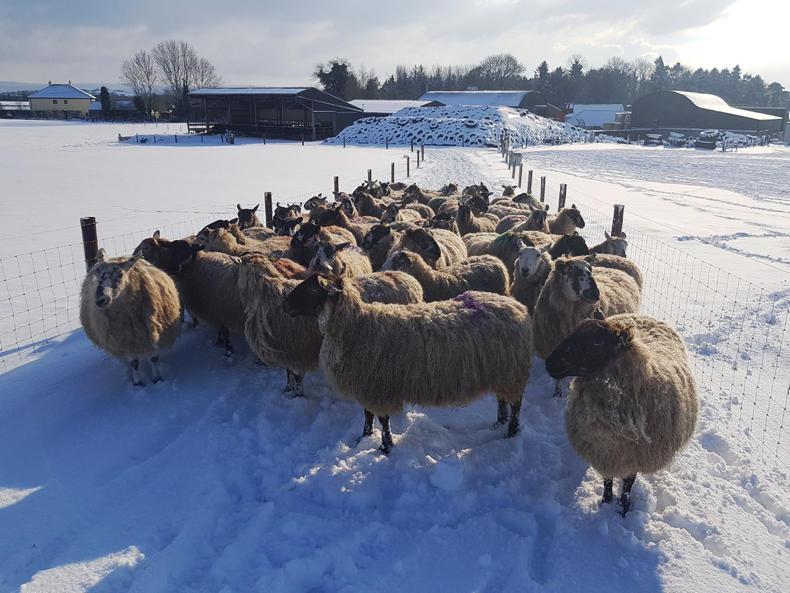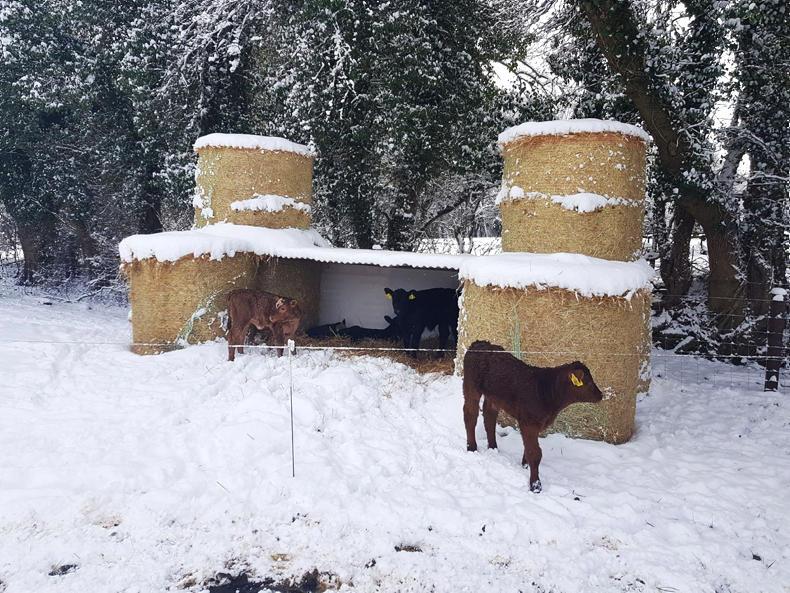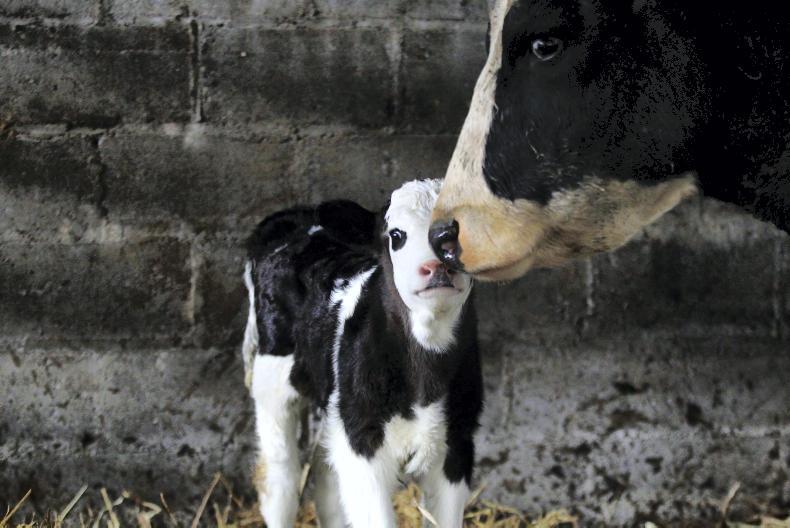One of the first issues we encountered in January 2017 was Johne’s disease. We noticed a young cow losing condition for no reason and on Donal Lynch’s (Tullamore Farm vet) advice the cow was blood sampled. The sample came back positive for Johne’s disease.
Johne’s is a complicated disease where animals can have a positive blood test but not be actively shedding the disease.
A faecal sample will determine if the disease is being shed. This was the next step in this case and the faecal sample also came back positive. The cow was culled straight away before calving started for fear of other calves becoming infected at calving time.
The plan for the herd going forward is to blood test on an annual basis at the annual herd test for TB. There are three more cows in the herd that have tested positively for blood and these animals will be monitored more closely with six-month faecal tests to make sure there is no shedding.
They will also be culled as soon as possible. Frozen colostrum is sourced from a herd that is Johne’s-free. All purchased stock have to have a clear Johne’s blood test prior to entering the farm.
Tetany
One of the biggest issues on the farm in 2017 was tetany. Three cows were lost, two confirmed tetany and one suspected tetany. A lot of reseeding took place in late 2016 and early 2017, so cows were grazing lush swards of leafy grass.
While high-magnesium licks were available in paddocks until the end of May, two cows were lost in May and one in August. After the second case in May, straw was introduced as a long fibre source and magnesium was added to drinking troughs. The farm is low in potassium and spreading K fertiliser can lock up magnesium availability to animals so it’s an issue as to how we build the soil K index.
So what will be done differently in 2018? At the moment cows that were outdoors until last week were getting silage and 2kg of meal with 60g of sweetened cal-mag daily.
Boluses are currently being looked at once the cows move to the out-farm as feeding meal to a large group will not be practical. The boluses will cost €11/cow and will only cover 3-4 weeks but at the moment it looks like the best option.
Listeriosis
Ewes were housed at the end of December after grazing reseeded swards for November and December. There has been three losses since housing. All losses are being put down to listeriosis, with ewes demonstrating clinical signs of holding their head to one side. Another ewe with similar symptoms responded to antibiotic treatment.

All singles and some twins are in a paddock beside the yard being supplemented with silage and feed buckets.All singles and some twins are in a paddock beside the yard being supplemented with silage and feed buckets.
Ewes were being fed baled silage off paddocks and were switched to pit silage once these cases occurred. The thinking was that during baling some of the reseeded paddocks some soil may have made its way into bales due to a sod not being fully formed. Feeders are being cleaned out weekly to make sure there is no build up of rotten silage.
This week
Due to storm Emma, 20 cows and calves were housed last Wednesday. This has put pressure on housing and has meant that farm staff are on high alert for incidences of scour and pneumonia. The weather conditions will have heightened stress levels in animals and this could lower immunity levels and lead to disease outbreaks.
Straw bedding levels have increased in all sheds and especially in calving sheds. Cows and calves will be turned back out as soon as possible over the next few days.

A shelter was constructed along a sheltered ditch made out of straw bales, an old sliding door and some corri board. An electric fence was put around the outside and calves made their way inside to a dry lie and shelter from the wind.A shelter was constructed along a sheltered ditch made out of straw bales, an old sliding door and some corri board. An electric fence was put around the outside and calves made their way inside to a dry lie and shelter from the wind.
Fifty-nine heifers remained outdoors last week as there was no housing for them in the yard. These heifers were on kale during the winter months and were well acclimatised to rough weather conditions.
They were supplemented with silage and meal during the last week and no issues have been observed with them. Water has returned to most sheds in the yard and this has reduced labour requirements during an already very busy period on the farm.
One of the first issues we encountered in January 2017 was Johne’s disease. We noticed a young cow losing condition for no reason and on Donal Lynch’s (Tullamore Farm vet) advice the cow was blood sampled. The sample came back positive for Johne’s disease.
Johne’s is a complicated disease where animals can have a positive blood test but not be actively shedding the disease.
A faecal sample will determine if the disease is being shed. This was the next step in this case and the faecal sample also came back positive. The cow was culled straight away before calving started for fear of other calves becoming infected at calving time.
The plan for the herd going forward is to blood test on an annual basis at the annual herd test for TB. There are three more cows in the herd that have tested positively for blood and these animals will be monitored more closely with six-month faecal tests to make sure there is no shedding.
They will also be culled as soon as possible. Frozen colostrum is sourced from a herd that is Johne’s-free. All purchased stock have to have a clear Johne’s blood test prior to entering the farm.
Tetany
One of the biggest issues on the farm in 2017 was tetany. Three cows were lost, two confirmed tetany and one suspected tetany. A lot of reseeding took place in late 2016 and early 2017, so cows were grazing lush swards of leafy grass.
While high-magnesium licks were available in paddocks until the end of May, two cows were lost in May and one in August. After the second case in May, straw was introduced as a long fibre source and magnesium was added to drinking troughs. The farm is low in potassium and spreading K fertiliser can lock up magnesium availability to animals so it’s an issue as to how we build the soil K index.
So what will be done differently in 2018? At the moment cows that were outdoors until last week were getting silage and 2kg of meal with 60g of sweetened cal-mag daily.
Boluses are currently being looked at once the cows move to the out-farm as feeding meal to a large group will not be practical. The boluses will cost €11/cow and will only cover 3-4 weeks but at the moment it looks like the best option.
Listeriosis
Ewes were housed at the end of December after grazing reseeded swards for November and December. There has been three losses since housing. All losses are being put down to listeriosis, with ewes demonstrating clinical signs of holding their head to one side. Another ewe with similar symptoms responded to antibiotic treatment.

All singles and some twins are in a paddock beside the yard being supplemented with silage and feed buckets.All singles and some twins are in a paddock beside the yard being supplemented with silage and feed buckets.
Ewes were being fed baled silage off paddocks and were switched to pit silage once these cases occurred. The thinking was that during baling some of the reseeded paddocks some soil may have made its way into bales due to a sod not being fully formed. Feeders are being cleaned out weekly to make sure there is no build up of rotten silage.
This week
Due to storm Emma, 20 cows and calves were housed last Wednesday. This has put pressure on housing and has meant that farm staff are on high alert for incidences of scour and pneumonia. The weather conditions will have heightened stress levels in animals and this could lower immunity levels and lead to disease outbreaks.
Straw bedding levels have increased in all sheds and especially in calving sheds. Cows and calves will be turned back out as soon as possible over the next few days.

A shelter was constructed along a sheltered ditch made out of straw bales, an old sliding door and some corri board. An electric fence was put around the outside and calves made their way inside to a dry lie and shelter from the wind.A shelter was constructed along a sheltered ditch made out of straw bales, an old sliding door and some corri board. An electric fence was put around the outside and calves made their way inside to a dry lie and shelter from the wind.
Fifty-nine heifers remained outdoors last week as there was no housing for them in the yard. These heifers were on kale during the winter months and were well acclimatised to rough weather conditions.
They were supplemented with silage and meal during the last week and no issues have been observed with them. Water has returned to most sheds in the yard and this has reduced labour requirements during an already very busy period on the farm.








 This is a subscriber-only article
This is a subscriber-only article













SHARING OPTIONS: